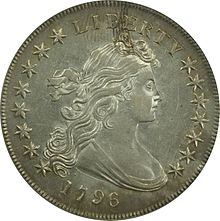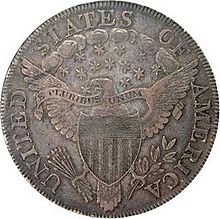United States | |
| Value | 1.00 U.S. dollars |
|---|---|
| Mass | 26.96 g |
| Diameter | 39–40 mm |
| Edge | Lettered |
| Composition | |
| Years of minting | 1795–1804 |
| Obverse | |
 | |
| Design | Bust of Liberty |
| Design date | 1795 |
| Reverse | |
 | |
| Design | A bald eagle |
| Design date | 1795 |
 | |
| Design | A bald eagle in heraldic form |
| Design date | 1798 |
The Draped Bust dollar is a United States dollar coin minted from 1795 to 1803, and was reproduced, dated 1804, into the 1850s. The design succeeded the Flowing Hair dollar, which began mintage in 1794 and was the first silver dollar struck by the United States Mint. The designer is unknown, though the distinction is usually credited to artist Gilbert Stuart. The model is also unknown, though Ann Willing Bingham has been suggested.
In October 1795, newly appointed Mint Director Elias Boudinot ordered that the legal fineness of 0.892 (89.2%) silver be used for the dollar rather than the unauthorized fineness of 0.900 (90%) silver that had been used since the denomination was first minted in 1794. Due largely to a decrease in the amount of silver deposited at the Philadelphia Mint, coinage of silver dollars declined throughout the latter years of the 18th century. In 1804, coinage of silver dollars was halted; the last date used during regular mint production was 1803.
In 1834, silver dollar production was temporarily restarted to supply a diplomatic mission to Asia with a special set of proof coins. Officials mistakenly believed that dollars had last been minted with the date 1804, prompting them to use that date rather than the date in which the coins were actually struck. A limited number of 1804 dollars were struck by the Mint in later years, and they remain rare and valuable.